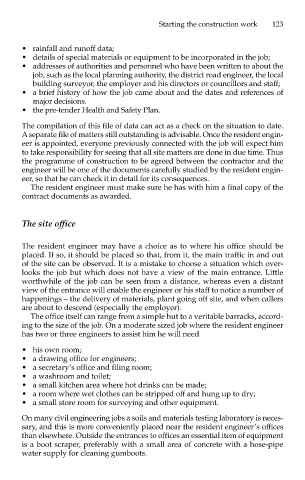Page 138 - Civil Engineering Project Management, Fourth Edition
P. 138
123
Starting the construction work
• rainfall and runoff data;
• details of special materials or equipment to be incorporated in the job;
• addresses of authorities and personnel who have been written to about the
job, such as the local planning authority, the district road engineer, the local
building surveyor, the employer and his directors or councillors and staff;
• a brief history of how the job came about and the dates and references of
major decisions.
• the pre-tender Health and Safety Plan.
The compilation of this file of data can act as a check on the situation to date.
Aseparate file of matters still outstanding is advisable. Once the resident engin-
eer is appointed, everyone previously connected with the job will expect him
to take responsibility for seeing that all site matters are done in due time. Thus
the programme of construction to be agreed between the contractor and the
engineer will be one of the documents carefully studied by the resident engin-
eer, so that he can check it in detail for its consequences.
The resident engineer must make sure he has with him a final copy of the
contract documents as awarded.
The site office
The resident engineer may have a choice as to where his office should be
placed. If so, it should be placed so that, from it, the main traffic in and out
of the site can be observed. It is a mistake to choose a situation which over-
looks the job but which does not have a view of the main entrance. Little
worthwhile of the job can be seen from a distance, whereas even a distant
view of the entrance will enable the engineer or his staff to notice a number of
happenings – the delivery of materials, plant going off site, and when callers
are about to descend (especially the employer).
The office itself can range from a simple hut to a veritable barracks, accord-
ing to the size of the job. On a moderate sized job where the resident engineer
has two or three engineers to assist him he will need
• his own room;
• a drawing office for engineers;
• a secretary’s office and filing room;
• a washroom and toilet;
• a small kitchen area where hot drinks can be made;
• a room where wet clothes can be stripped off and hung up to dry;
• a small store room for surveying and other equipment.
On many civil engineering jobs a soils and materials testing laboratory is neces-
sary, and this is more conveniently placed near the resident engineer’s offices
than elsewhere. Outside the entrances to offices an essential item of equipment
is a boot scraper, preferably with a small area of concrete with a hose-pipe
water supply for cleaning gumboots.

